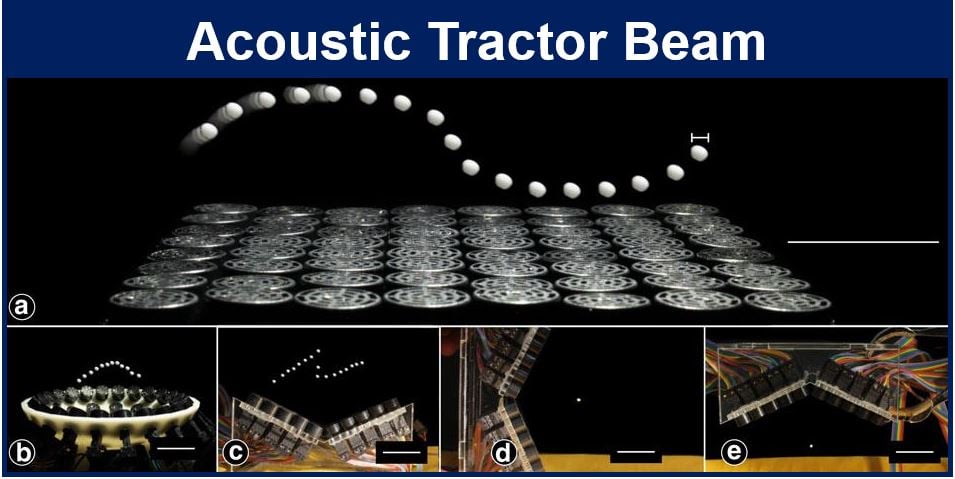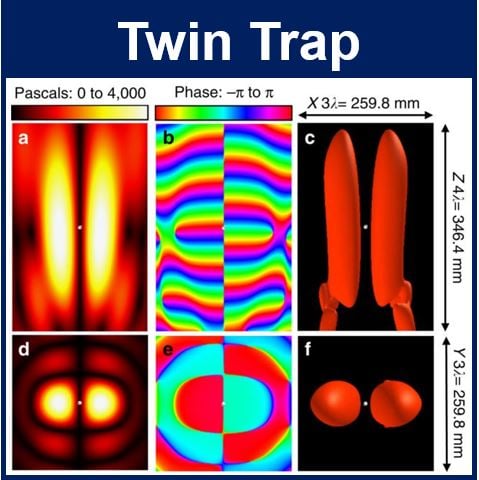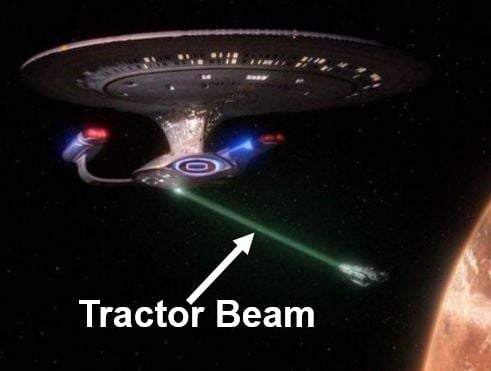A tractor beam, called a sonic tractor beam, has been created by a team of scientists from the Universities of Bristol and Sussex in England and the Universidad Pública de Navarra in Spain. The beam can lift and move objects with the use of sound waves.
Tractor beams, the stuff of Star Trek and Star Wars, are mysterious rays that can grab, lift and pull objects. The concept, which first entered the imaginations of science fiction novelists, has since come to fascinate engineers and scientists.
Researchers, who wrote of their achievement in the academic journal Nature Communications (citation below), say they have created a tractor beam that uses high-amplitude sound waves to generate an acoustic hologram that can grab small objects, lift and move them.
 Expanded polystyrene particles are levitated above single-sided arrays. The acoustic transducers are driven at 16 Vpp and 40 kHz. (a–c) The particles can be translated along 3D paths at up to 25 cms−1 using different arrangements and without moving the array. (c–e) The traps are powerful enough to hold the spheres and defy gravity from any direction. (Image: Nature Communications)
Expanded polystyrene particles are levitated above single-sided arrays. The acoustic transducers are driven at 16 Vpp and 40 kHz. (a–c) The particles can be translated along 3D paths at up to 25 cms−1 using different arrangements and without moving the array. (c–e) The traps are powerful enough to hold the spheres and defy gravity from any direction. (Image: Nature Communications)
Tractor beam has many possible applications
The technique could be developed for a vast range of applications, the authors say, for example, a sonic production line could move delicate objects and assemble them, all without the need for any physical contact.
This technology could eventually be developed so that it could grip and transport drug capsules or tiny surgical instruments through living tissue.
Lead author, Asier Marzo, PhD student at the Department of Computer Science, University of Bristol, said:
“It was an incredible experience the first time we saw the object held in place by the tractor beam. All my hard work has paid off, it’s brilliant.”
Bruce Drinkwater, Professor of Ultrasonics in the Department of Mechanical Engineering at the University of Bristol, added:
“We all know that sound waves can have a physical effect. But here we have managed to control the sound to a degree never previously achieved.”
 Amplitude field (a,d), phase field (b,e) and amplitude isosurfaces of 2 kPa (c,f). (Image: Nature Communications)
Amplitude field (a,d), phase field (b,e) and amplitude isosurfaces of 2 kPa (c,f). (Image: Nature Communications)
Beam seemingly defies gravity
Co-founder of Ultrahaptics Ltd., Prof. Sriram Subramanian, who works at the University of Sussex, explained:
“In our device we manipulate objects in mid-air and seemingly defy gravity. Here we individually control dozens of loudspeakers to tell us an optimal solution to generate an acoustic hologram that can manipulate multiple objects in real-time without contact.”
The scientists used an array of sixty-four tiny loudspeakers to create high-pitch and high-intensity sound waves.
The tractor beam works by surrounding an object with extremely high-intensity sound which creates a force field that keeps the object in place. By carefully controlling loudspeaker output, the object can either be held still, transported or rotated.
 This Star Trek tractor beam does not use sound. Sound is not possible if there is no air (there is no air in space).
This Star Trek tractor beam does not use sound. Sound is not possible if there is no air (there is no air in space).
The researchers have demonstrated that three different shapes of acoustic force fields work as effective tractor beams:
1. Tweezers: an acoustic force field similar to a pair of tweezers or two fingers.
2. Vortex: an acoustic vortex where the object becomes stuck-in and then trapped at the core.
3. Cage: a high-intensity cage that surrounds the object and holds it in place from all directions.
Previous experiments using acoustics had to surround the object with loudspeakers, which limited how much it could be moved and restricted many applications.
Citation: “Holographic acoustic elements for manipulation of levitated objects,” by Asier Marzo, Sue Ann Seah, Bruce W. Drinkwater, Deepak Ranjan Sahoo, Benjamin Long and Sriram Subramanian. Nature Communications. 27 Oct 2015. DOI: 10.1038/ncomms9661.
Video – An acoustic tractor beam
This video shows how acoustic holograms are projected from a flat surface – and contrary to traditional holograms, they exert considerable forces on the objects contained within them.
